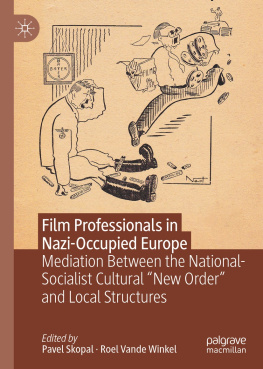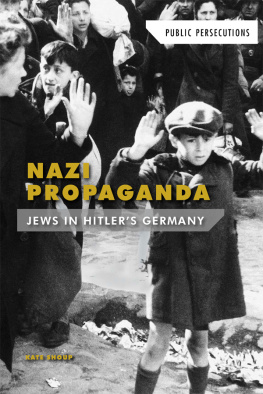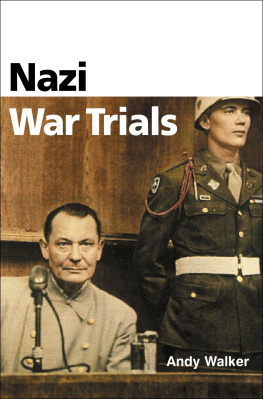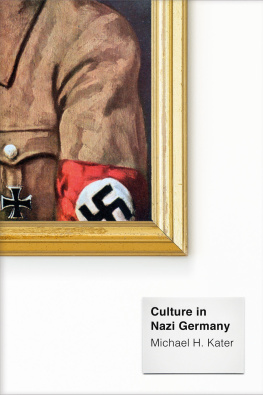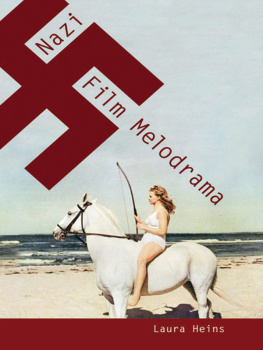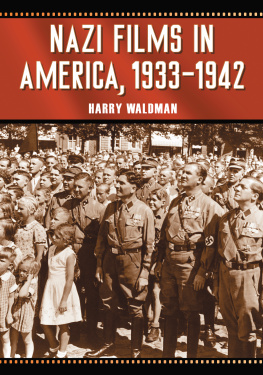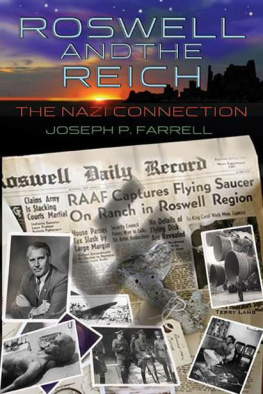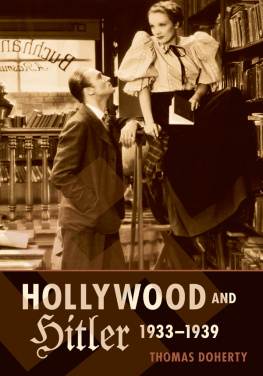PREFACE
At the risk of imitating Nazi cinemas reduction of history to pathos, I feel compelled to begin with a little confession. Namely, in the course of working through this material, I have been guilty of the very approaches which, much like a reformed alcoholic, I now lambaste. I started out with the usual conviction that Nazi films are of interest only as propaganda, and then advanced to a more sophisticated informed-by-film-theory stage that went something like this: These movies may look innocent, but this is why you, the ordinary viewer, need me, the film critic, to tell you why you shouldnt be enjoying them. In addition to being a bit arrogant, these perspectives are insufficient precisely because they answer our questions too completely, and hence may discourage the asking of further, more complex and disconcerting questions. For this reason, some films on which I published earlier articles (Jew Sss, Friedrich Schiller, and Komdianten) appear here in a vastly more ambivalent light.
I hope in this book to have achieved an epistemological reversal that is simple, but somehow daunting when its Nazi cinema youre talking about: rather than taking ideology as a starting point and looking at how movies show ideology, we can perhaps take movies as a starting point and examine how they harbor, transform, exceed, and undermine political ideology. If we start this way, we may see contradictions where we would most expect ideological homogeneity, and need not be vexed by movies that dont seem to fit.
I am indebted to a number of people for intellectual stimulation, critical feedback, and moral support at various stages of the project: Ellis Dye, J. Michele Edwards, Sander Gilman, Jrgen Link, Rick McCormick, Roswitha Mueller, Tom Plummer, Dana Polan, Eric Rentschler, Norm Rosenberg, David Sanford, Clay Steinman, Renate Werner, Caroline Wilbrecht, Jack Zipes, and my two anonymous readers. A special thanks to Nancy Armstrong for her open knife theory and to Slavoj iek for work that changed my whole approach to movies (and for those jokes and movie examples that give one the pleasurable illusion of having understood Lacan). Thanks to David Bathrick for first telling me to let competing imperatives speak in Nazi cinema, and to Gerhard Weiss, my key to the Frederick movies. Thanks also to Tom Browne, Brian Longley, Dave Reynolds, and Kristie Wheeler at Macalester College Media Services, to Al Milgrom, Bob Strong, Chris Barsanti, and Chris Nordling at the University of Minnesota Film Society, and to David Bathrick and John Mowitt for help with the still photographs. Thanks to Macmillan, Inc., for permission to reprint the chapter on Jew Sss, which appeared in Perspectives on German Cinema (1995). I am likewise grateful to Ken Wissoker and colleagues at Duke University Press, whose patience and humor have made collaboration a pleasure, and to the students of Macalester College, whose challenges and low tolerance for gratuitous theory-speak gave me just the kind of pressure I needed.
Finally, thanks to Linn and Daniel for putting up with a mother who blocked the VCR with Nazi movies, and to Jochen, whose ideas and works I have recklessly plundered, taking liberties one only dares with a (preferably current) spouse. His occasional critique, always in the tactful, mild-mannered style of German universities in the late sixties, is most definitely reflected in these pages.
INTRODUCTION
A few months ago, I watched a Hollywood movie called Swing Kids about a free-thinking boy in 1930s Germany who pays a price for his resistance to Nazi conformity.
Few would contest that the Nazi movies mentioned above are propaganda . But while we might decry Swing Kids as another exercise in the Culture Industrys reduction of history to kitsch, propaganda would likely not be our charge. What makes the Nazi films propaganda, wed say, is that theyre trying to make you sympathize with a terrible cause, while Swing Kids champions freedom. I wont be the first to point out that such distinctions depend upon context, upon which cause has been valorized by history or by a group fighting for hegemony. Lewis Milestones film version of All Quiet on the Western Front was propaganda of the most virulent sort in the eyes of the Nazis, which was why they staged massive protests at its Berlin premiere in December 1930.
The lesson to be gleaned from Swing Kids is, of course, the infinite corruptibility of narrative formations, whose structures can be filled with whatever content serves a given purpose. But it also illustrates another problematic that underlies this study: how to draw the line between propaganda and entertainment; more specifically, how to deal adequately with propaganda when it is entertainment. When Swing Kids shows us kids being brainwashed by Fritz Hipplers documentary The Eternal Jew (quite amazingly, a year before the film was produced), it is not showing Nazism at its most cunning, since Hipplers film is as tedious as it is heinous. Such Hollywood representations, which have become a form of memory as we collectively imagine Nazi Germany, do more than just deprive the era of its contradictions and heterogeneity; they rob it of the one thing even the most murderous state cannot live without: its normalcy. What I want to do here is fight movies with movies, to examine National Socialisms fusion, via its feature films, of the political with normal entertainment, which means with desire. My strategy will be to look at Nazi propaganda movies, only not as propaganda movies.
Not so very long ago an interest in propaganda was the only reason anybody had for giving Nazi movies a second thought. The pleasure The subject position of both writer and audience was defined beforehand as one of moral and aesthetic superiority, and thus never needed to be problematized or even articulated. The propaganda experience was not marred by complexity of any sort.
I want to resist the fashion of trashing early studies of Nazi film, like Erwin Leisers Nazi Cinema (originally 1968) or David Stewart Hulls Film in the Third Reich (1969), as untheoretical or superficial. Their work was an important first step that could not yet benefit from developments in film studies (or even from VCRs, for that matter), and few works on Nazi film fail to cite them. Yet early studies left much space for further exploration, having told us a lot about what surrounded Nazi films, such as the circumstances of production and distribution, and very little about the films themselves. As film studies has evolved since the mid-seventies, so has a theoretical apparatus that acknowledges the importance of low as well as high textual forms and that has furnished tools for reading them. Recent writing has thus begun exploring the Nazi entertainment genres usually ignored by early scholars who lacked either the tools or the reasons to investigate what was not overtly political. The result of new methodologies has been a blurring of boundaries: Even if we study propaganda, no longer can we restrict ourselves to unmasking the intentions behind films or to explicating their manipulation of presumably malleable subjects. By the same token, no longer can any feature film escape the political, since weve come to understand the inscription of ideologies in classical realist narrative form, regardless of what a director might have intended.


